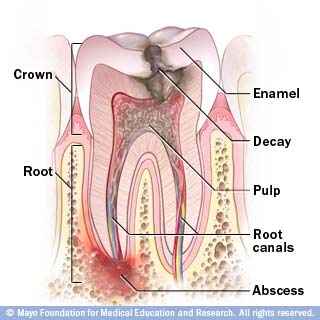Root Canal Treatment (Endodontic treatment)
Endodontic treatment is the removal of the pulp from the tooth in order to preserve it. Root Canal Treatment is most often done in one visit with a high success rate.
Signs you may need a root canal include:
Damaged Tooth Requiring a Root Canal Treatment
- Severe toothache pain upon chewing or application of pressure
- Prolonged sensitivity/pain to heat or cold temperatures (after the hot or cold has been removed)
- Discoloration (a darkening) of the tooth
- Swelling and tenderness in the nearby gums
- A persistent or recurring pimple on the gums
- Fractured or broken tooth due to trauma.
- Sometimes no symptoms are present
Root Canal treatment is necessary when the pulp becomes inflamed or infected.
The inflammation or infection can have a variety of causes: deep decay, repeated dental procedures on the tooth, faulty crowns, or a crack or chip in the tooth. In addition, trauma to a tooth may cause pulp damage even if the tooth has no visible chips or cracks. If pulp inflammation or infection is left untreated, it can cause pain or lead to an abscess.
Root canal treatment is a completely painless procedure that is done under local anesthesia. It allows us to save your tooth for many years.
Painless Treatment.
Step 1 - The dentist will numb your gums.
Step 2 - Once your gums are numb, the doctor will give you a shot of local anesthesia that will completely numb your tooth, gum, tongue, and skin in that area.
Step 3 - The dentist will remove the pulp and the nerves from the tooth and fill the remaining space with a medicated material called gutta-percha, and will place a temporary filling** on the tooth.
At this point the Root Canal Treatment is finished however, while you will no longer have pain, the tooth will now need to be restored
After the root canal, a post and crown (cap) is often needed to properly restore the tooth. The temporary filling** that is placed in your tooth after RCT will be removed by the doctor. The dentist will shape the tooth and then takes an impression of the tooth. A technician uses the impression to fabricate a crown that perfectly matches your other teeth. Your treatment is now complete.
*NOTE: Most Root Canal failures that we see in our practice are in patients that either did not get the crown placed or chose to place it too late. In most cases we recommend placement of crowns within 1-2 weeks of Root Canal completion.
**If you notice that a piece of the temporary filling came out, it's not a cause for alarm. You may come in to have it adjusted or replaced. Or come in for your next scheduled appointment for permanent restoration.




